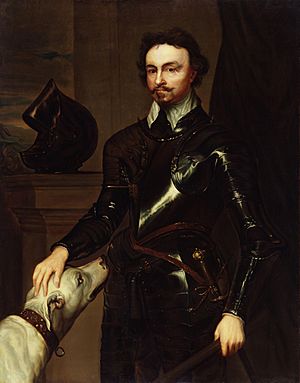The Graces (Ireland) facts for kids
The Graces were a series of important promises and reforms that Roman Catholics in Ireland hoped to get between 1628 and 1634. For a long time, since the Reformation in Ireland changed the official religion, Catholics in Ireland had fewer rights. They wanted to be treated fairly and have a full role in Irish society.
Important Catholics in the Irish government, including both families with English roots (called Old English) and native Irish leaders, asked King Charles I to make these changes. The King seemed to agree, but his main representative in Ireland, Thomas Wentworth, stopped many of these plans. This made many people unhappy and was one reason for the Irish Rebellion of 1641.
Contents
Why the Graces Were Needed
During a war with Spain (1625–1630), Charles I of England needed soldiers in Ireland to protect the country. Even though the official church had changed to Protestantism, most people in Ireland were still Catholic.
When King Charles I became king in 1625, many Catholics had high hopes. His wife, Queen Henrietta Maria, was a Catholic princess from France. Wealthy Catholics in the Irish Parliament, like Lord Killeen and Sir William Talbot, 1st Baronet, formed a group. They asked the King to remove laws that were unfair to Catholics.
How the Graces Were Agreed Upon
In 1626, King Charles I hinted that he would give certain rights to Irish Catholics and landowners. But he wanted a good amount of money in return.
In June 1627, a special meeting chose 11 people to go to England. These "agents" would talk directly with the King. Eight of them were Catholic leaders, and three were Protestant. They included:
- Lord Killeen
- Sir Thomas Lutrell
- Sir William Talbot, 1st Baronet
- Sir Lucas Dillon
- Sir Henry Lynch, 1st Baronet
- Sir Edward FitzHarris
- Sir John Meade
- Lord Power
- Richard Osborne
- Arthur Forbes
- Andrew Stewart
In 1628, at Whitehall in London, the King and the Irish group agreed on 51 points. These agreements became known as "The Graces." The main points were about land rights and allowing Catholics more religious freedom. In return, the Irish agreed to pay £120,000 over three years. The King announced the Graces, and the first payment was made.

Why the Graces Were Not Fully Approved
The Irish Parliament was supposed to officially approve the Graces quickly. However, the King's representative, Lord Falkland, never called the Parliament meeting needed to do this.
The next Irish Parliament met in late 1634. This was the first time Parliament had met since the Graces were announced. The new leader in Ireland was Thomas Wentworth, 1st Earl of Strafford, who became the Lord Deputy of Ireland in 1632. Wentworth's main goal was to make Ireland more profitable for King Charles.
The first things Parliament did were to approve new taxes, which passed easily. Catholic members agreed to these taxes because they expected the 51 Graces to be approved in the next part of the Parliament session. For a short time, Catholic members even had more votes than Protestants, which made them hopeful.
However, on November 27, Wentworth refused to allow two of the Graces. These two points were very important to Catholics. One would have protected their land ownership in Connacht, a province where most landowners were Catholic. Because of this, Catholic members then opposed all other laws Wentworth tried to pass. The Graces were put aside, even after more appeals to King Charles.
Historians still discuss whether Wentworth's actions were fair or if the Catholic members should have accepted 49 out of 51 Graces.
What Happened Next
The failure of the Graces made many people in Ireland very upset. Wentworth then made things worse by challenging the land titles of many Old English families in Connacht. These families had to pay large fines to keep their land.
This growing anger helped lead to the Irish Rebellion of 1641. The rebellion eventually led to the formation of Confederate Ireland and later, the Cromwellian conquest of Ireland in 1649–53.
In England, Wentworth was put on trial by Parliament and executed in May 1641. After his death, King Charles and his advisors told the Irish leaders to pass the laws needed to make the Graces official. But these reforms were not fully put into action before the rebellion started later in 1641.
See also


